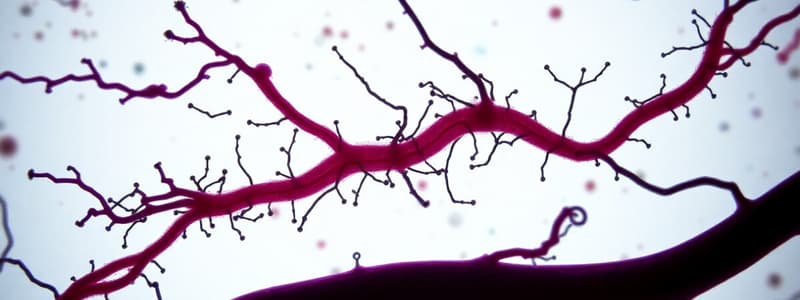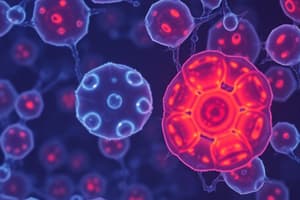Podcast
Questions and Answers
What is the primary function of the Golgi Apparatus?
What is the primary function of the Golgi Apparatus?
Prokaryotic cells do not contain a nucleus.
Prokaryotic cells do not contain a nucleus.
True
What is the difference between a photoautotroph and a chemoautotroph?
What is the difference between a photoautotroph and a chemoautotroph?
A photoautotroph uses light for energy, while a chemoautotroph uses chemical reactions.
The basic structural and functional unit of life is the ______.
The basic structural and functional unit of life is the ______.
Signup and view all the answers
Match the following organelles with their functions:
Match the following organelles with their functions:
Signup and view all the answers
Which microscope is best for observing surface structures of cells?
Which microscope is best for observing surface structures of cells?
Signup and view all the answers
All eukaryotic cells contain a cell wall.
All eukaryotic cells contain a cell wall.
Signup and view all the answers
What are microtubules and what role do they play in the cell?
What are microtubules and what role do they play in the cell?
Signup and view all the answers
During binary fission, the cell divides into two ______ cells.
During binary fission, the cell divides into two ______ cells.
Signup and view all the answers
Which scientist is credited with the term 'cell' after observing cork under a microscope?
Which scientist is credited with the term 'cell' after observing cork under a microscope?
Signup and view all the answers
Which of the following structures is NOT a component of the cell membrane?
Which of the following structures is NOT a component of the cell membrane?
Signup and view all the answers
All prokaryotes obtain nutrition in the same way.
All prokaryotes obtain nutrition in the same way.
Signup and view all the answers
What are the two categories of prokaryotes?
What are the two categories of prokaryotes?
Signup and view all the answers
A pathogen is an organism that can cause a __________.
A pathogen is an organism that can cause a __________.
Signup and view all the answers
Match the following prokaryotic reproduction and structures with their descriptions:
Match the following prokaryotic reproduction and structures with their descriptions:
Signup and view all the answers
What is the primary purpose of the Gram-staining technique?
What is the primary purpose of the Gram-staining technique?
Signup and view all the answers
Gram-positive bacteria retain the purple crystal violet dye after the staining process.
Gram-positive bacteria retain the purple crystal violet dye after the staining process.
Signup and view all the answers
Describe one benefit of endospores for prokaryotic cells.
Describe one benefit of endospores for prokaryotic cells.
Signup and view all the answers
The extracellular matrix provides __________ support to cells.
The extracellular matrix provides __________ support to cells.
Signup and view all the answers
Which of these statements is true regarding the diversity of prokaryotes?
Which of these statements is true regarding the diversity of prokaryotes?
Signup and view all the answers
Study Notes
Prokaryotes and Eukaryotes
- Prokaryotes: Lack a nucleus and other membrane-bound organelles. Smaller and simpler
- Eukaryotes: Possess a nucleus and membrane-bound organelles; more complex and larger
Microscopy
- Light Microscope (LM): Uses visible light to view specimens. Relatively low magnification and resolution
- Scanning Electron Microscope (SEM): Creates a 3D image of a specimen surface using a beam of electrons. High magnification and resolution, excellent for surface details, often metal-coated specimen
- Transmission Electron Microscope (TEM): Passes a beam of electrons through a very thin specimen. High magnification and resolution, excellent for internal structures
- Dissecting Microscope: Used to view larger specimens with lower magnification for detailed visual study
Nutritional Modes
- Chemoautotroph: Energy from chemical reactions, carbon from inorganic sources (e.g., CO2)
- Chemoheterotroph: Energy and carbon from organic compounds
- Photoautotroph: Energy from sunlight, carbon from inorganic sources (e.g., CO2)
- Photoheterotroph: Energy from sunlight, carbon from organic compounds
Prokaryotic Reproduction and Processes
- Binary Fission: Asexual reproduction in prokaryotes, where the cell divides into two identical daughter cells
- Conjugation: Genetic material exchange between prokaryotic cells
- Endospore: A protective structure formed by some bacteria under unfavorable conditions for survival
Eukaryotic Organelles
- Endoplasmic Reticulum (ER): Network of membranes involved in protein synthesis and lipid metabolism, smooth or rough
- Golgi Apparatus: Modifies, sorts, and packages proteins and lipids for secretion
- Vesicle: Membrane-bound sac involved in transport and storage
- Lysosome: Contains enzymes for intracellular digestion and waste removal
- Microfilaments: Protein fibers that form part of the cytoskeleton, involved in cell movement (e.g., muscle contraction)
- Microtubules: Hollow tubes that are part of the cytoskeleton, providing support and involved in cell movement (e.g., cilia and flagella)
- Cytoskeleton: Network of protein filaments (microfilaments and microtubules) that maintain cell shape, support, and allow movement
- Fluid Mosaic Model: Describes the cell membrane as a fluid structure with embedded proteins, phospholipids, and other molecules
- Peptidoglycan: Important polysaccharide/amino-acid polymer and part of the bacterial cell wall structure; structural support
Other Cellular Structures
- Cilia: Short, hair-like projections for cell movement
- Pili: Hair-like projections for attachment and conjugation
- Glycoprotein: Protein with a carbohydrate chain attached, found in the cell membrane
- Peripheral Protein: Membrane protein that is not embedded in the lipid bilayer
- Channel Protein: Membrane protein that creates a channel for specific molecules to pass through
Cell Theory and Evolution
- Classical Cell Theory: All organisms are composed of one or more cells; the cell is the basic unit of organisms; all cells come from pre-existing cells.
- Evolution of Cell Theory: Over time, concepts like the importance of cell's internal components (organelles) and cell diversity have emerged
Scientists' Contributions to Cell Theory
- Robert Hooke: First to observe and name cells, seeing cells in cork.
- Antonie van Leeuwenhoek: Observed microorganisms, increasing understanding of cellular diversity.
- Matthias Schleiden: Determined that plants are composed of cells.
- Theodor Schwann: Determined that animals are composed of cells.
- Rudolf Virchow: Proposed that cells come from pre-existing cells.
Identifying Prokaryotic vs. Eukaryotic Cells
- Presence of a nucleus: Eukaryotic cells have a nucleus; prokaryotic cells do not.
- Membrane-bound organelles: Eukaryotes have these; prokaryotes do not.
- DNA organization: Eukaryotic DNA is organized into chromosomes within the nucleus; prokaryotic DNA is a circular loop found in the nucleoid region
Light vs. Electron Microscopes
- Light microscopes use visible light, have lower resolution and magnification, are suitable for viewing larger specimens, living cells, and thin sections.
- Electron microscopes use beams of electrons, offer much higher resolution and magnification. Helpful for viewing internal structures, but cannot be used to view live organisms.
Lab Procedure for Microscopy
- Prepare slide: Place sample on a slide(with a solution), cover with a coverslip, ensuring no air bubbles
- Adjust light: Align and adjust light source
- Select objective: Start with the lowest magnification
- Focus: Using the course adjustment knob, focus until a clear image appears
- Fine-tune: Use the fine adjustment knob to enhance clarity and details
- Observe: Carefully observe and draw your observations.
Specific Microscope Types
- Scanning Electron Microscope (SEM): Provides detailed surface view of 3D samples, especially of smaller samples
- Transmission Electron Microscope (TEM): Provides extremely high resolution of internal sample details, particularly of thin sections of samples
- Compound Light Microscope: A more basic and common type of microscope suitable for specimens that need less magnification
- Dissecting Light Microscope: Used for detailed viewing of large and/or three-dimensional objects, like dissections of biological samples.
Endosymbiotic Theory
- Process: Suggests that organelles like mitochondria and chloroplasts were once independent prokaryotes that were engulfed by a larger host cell.
- Evidence: These organelles have their own DNA, ribosomes, and two membranes; they divide by binary fission similar to bacteria
Cellular Organelles and Function
Cell Boundary
- Structure: Plasma membrane (phospholipid bilayer) in all cells; the cell wall is a more complex outer boundary found in plants and bacteria, different from the plasma membrane
- Differences: Different cells have different cell walls (plants vs animals); cells need plasma membrane structure
Cell Membrane Structure
- Diagram: Draw a fluid mosaic model of the cell membrane with phospholipid layers, cholesterol, glycoproteins, and glycolipids, and membrane proteins.
Prokaryotic Categories
- Bacteria: Cell wall contains peptidoglycan.
- Archaea: Cell wall does not contain peptidoglycan (often more resistant to harsh environmental conditions)
Gram Staining
- Purpose: Classifies bacteria based on their cell wall structure, helping in diagnosis and treatment, often used to see the differences between Gram-positive and Gram-negative bacteria.
- Results: Gram-positive bacteria stain purple, gram-negative stain pink/red. These differences help distinguish organisms
Binary Fission, Endospore, and Conjugation
- Binary Fission: Cell division producing two identical daughter cells, a form of asexual reproduction
- Endospore: A protective, dormant structure allowing survival in harsh conditions.
- Conjugation: Transfer of genetic material between two cells; a form of horizontal gene transfer.
Prokaryotic Diversity
- Similarities: All share basic characteristics: Cell wall, ribosomes, plasma membrane, single circular chromosome and DNA and prokaryotic characteristics
- Differences: Different metabolic pathways, nutritional needs, and reproductive strategies are present; some bacteria have specialized structures or strategies for surviving in harsh environments.
Pathogens and Prokaryotes
- Pathogen: Organisms that cause disease.
- Relationship: Many prokaryotes are pathogens, causing diseases in humans and other organisms
Studying That Suits You
Use AI to generate personalized quizzes and flashcards to suit your learning preferences.
Description
This quiz covers key concepts in biology, focusing on the differences between prokaryotes and eukaryotes, as well as various microscopy techniques. Additionally, it explores different nutritional modes utilized by these organisms. Test your knowledge on these fundamental topics in cellular biology!




